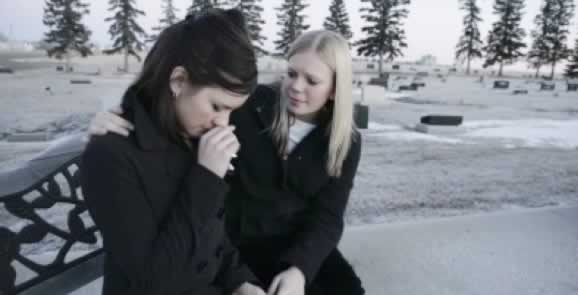In the time following a loved one’s death, a time when individuals and families are in the process of grieving the loss, they will begin to make attempts at establishing ways to remember the loved one. This usually begins with the funeral/memorial service where family and friends recognize and remember the person. The service is a time of sharing memories and saying last good-byes.
A touch point can best be described, according to the dictionary, as “a mark or effect left… a place that will emphasize or bring notice to a person at a special moment when a tender touch or remembrance is needed.”
Deep within the human spirit is the need to honor and remember the people we love. It is almost an unheard cry of the soul to pledge never to forget the person and his or her part in our lives. Because of this desire to keep memories alive, people are impressed to make touch points (places to remember their loved ones). These touch points are not only physical reminders, but they also contribute to bringing comfort and peace to the heart and soul. Some touch points help bring closure in a loss. Others serve to provide an ongoing source of remembrance whenever they cross our paths, our minds and our thoughts. Touch points become a valuable part of grief recovery and a return to moving into a place of acceptance and restoration. Following are some suggested ideas for touch points:
- The cemetery gravesite is a good place to begin. Choosing a marker and meaningful inscriptions are important. Give yourself enough time after the service to sit down and put the name/dates/symbols and additional words together before you make a decision to order the marker. Markers usually take a number of weeks for completion, so you have time to think about what it will say about your loved one. Give yourself time!
- For families who choose cremation, there are a number of options that can help to build “touch points” for you. You may choose to use an urn/box for the ashes and keep them at home. You may choose to scatter the ashes, and when doing so, the time, place and people involved can be a memory builder for everyone. Photos, poems, etc., can become a part of the family’s good-bye to their loved one. The place and time you choose will set in motion a yearly remembrance of your loved one that will provide sweet memories.
- In situations where a death has been an accident, one way that many families choose to remember is to put a cross/flowers at the location where the accident occurred. These sites are healing for a family member to see, and the public will be made aware of the death. Most families will replace the flowers or cross on a regular basis for many years. Sometimes in cases of homicide, drowning, etc., a memorial place can be established at the location.
- When a death occurs at a location where a permanent memorial cannot be placed, then a family may choose to plant a tree in a park, along a roadside, at their church, or at their home. A living tree/plant represents a life well lived and a promise that life goes on. A memorial at a church, youth center, community center, and park are also options. Many times a family can place a memorial marker at the site with their loved one’s name.
- No matter what the cause or situation of death, there are numerous ways a family can make their loved one’s life remembered. Your home is usually the most important place to remember your loved one: pictures on the wall, maybe a wall of pictures from childhood up to the present. Keepsake boxes with personal items are good. Making the memory in your home can be suited to highlight your loved one’s interests and personality. For instance, if he or she liked race cars, the “picture wall” could reflect this with cars and banners. If a woman is a homemaker, then add items to the wall that reflect her talents, such as quilt squares, pictures of children, a favorite necklace, a hat or recipe (framed). Let your imagination flow! Each time people come into the home, they will be drawn to what that person’s life reflected.
- A touch point can be established by finding a special place or a corner of your home where you can go to be alone with your loss. For instance, a quiet patio with plants, comfortable chairs, a view of the clouds and the sky could become your “touch point” place for remembering. You could place a candle, a small picture or a vase with a rose on a table nearby and use this area for your daily devotions and prayer. Tell your family that this is your place to be alone. Find a corner with a comfortable chair in your bedroom or living room and do the same. Finding a place of your own is important. Men may find that the outdoors is good — a familiar walking path in the park, a chair in the garage or workshop, a bench in the backyard. Be creative and think of what your needs will be for a “touch point” place of your own. Sometimes you may decide to plant flowers in a planter/flower bed, and as they bloom, place holiday items with them, such as plastic windmills that move with the wind, Easter eggs, flags, pumpkins, anything seasonal. On birthdays and anniversaries, release balloons with notes, fly kites or fly seasonal banners. Children especially enjoy visual remembrances. Let them decorate, make pictures, write songs or poems. Help them make memory books to use as touch points for themselves.
- Listed below are many different ideas for making memories. With an infant, child or teen’s death, I suggest purchasing a type of chest (like a hope chest) or a decorative box and begin to build memories by placing personal items of the child’s inside the chest or box. Some people may prefer to make their own boxes if handy with wood or other materials. Inside the boxes place items like favorite stuffed animals, dolls, cars and toys. Select a favorite outfit, like a shirt, sweater, dress or hat to place in the box. Put together a favorite book, the child’s own creative work, a favorite picture, tape or CD, jewelry, school items and a blanket/quilt or pillow. In other words, you are building a chest of your child’s favorites things. As you select these items, you will find so much to treasure as memories. It will be difficult, so take your time. If it takes a year or two, don’t worry. You can always go back at any time, sit down and open the lid and allow yourself to enjoy that special child and add another memory item.
- Making photo albums or scrapbooks are ways of preserving a person’s life for now and future generations. However, I recommend that you wait for a period of time after your loss before you begin these projects. Most of the time, this type of project brings memories rushing in before a person has had enough time to heal from the loss. Usually the second or third year after a loss is manageable for most people. Be good to yourself and try not to rush into a project that you are not ready to handle. Scrapbooks and photo albums can be set aside until the time is right.
- Deciding how and when to make a memory or memories of loved ones will differ with each individual. Each person can be creative in his or her own way. Some women will design and make a quilt, while others may make individual quilt squares with pictures/verses and frame them for a picture wall. Some people will write a poem, keep a journal or have a shirt made (with a picture) or a cap with the person’s name on it (kids love to wear these). Internet sites for high schools, colleges and clubs are available to post pictures/info about a loved one’s death. Most high schools have website postings of alumni who have died. A flower or vegetable garden can be planted and provide a year-round opportunity for memories. This type of memory provides not only beauty and gifts of food, but opportunities to be outdoors and for exercise. Post a sign, “Sally’s garden,” and provide a place for others to remember.
- Holidays and seasons provide many opportunities to make touch points. Because holidays, like birthdays and the anniversary of a death, are so difficult to experience, especially the first year, it is important to find one or two ways to remember your loved one at these times. The simpler, the better! At Christmas, try buying an ornament for the tree that makes a statement about the loved one. For instance, you can buy one for the music lover, the fisherman, the hockey fan, the cook, etc. Start a practice of purchasing a different ornament each Christmas with the same theme. As you decorate the tree each year, you will make a special place for each ornament, and your family will remember. If you hang stockings, don’t change your tradition. Try having family members write a little note to put in the loved one’s stocking. At Thanksgiving, have each person take turns around the dinner table sharing a special memory about the loved one. With all the holidays, use your imagination to do something creative and special.
- One of the best ways to make touch points is to visit the cemetery (if possible) and spend some time sitting on the grass, just remembering. You may place a note with the flowers, place a small cross and choose an item to leave as a reminder. This is a place you can always go to when you choose. It provides a reminder to you of a special person who was a part of your life.
GriefShare is a grief recovery support group program for people grieving the death of a loved one. GriefShare groups meet in thousands of churches around the world. For more information about GriefShare or if you would like to find a GriefShare group meeting near you, visit www.griefshare.org or call 1-800-395-5755.
Copyright © MMV by The Church Initiative, Inc. All rights reserved.










